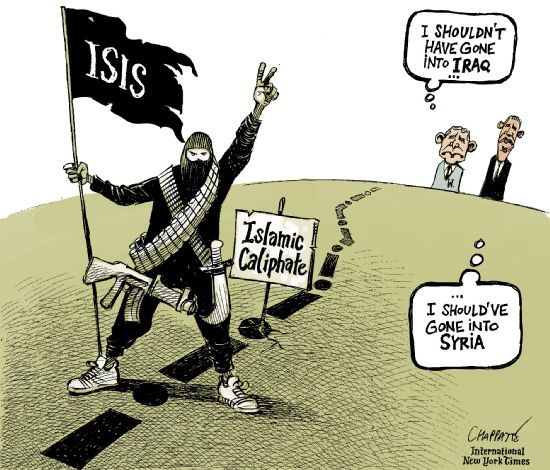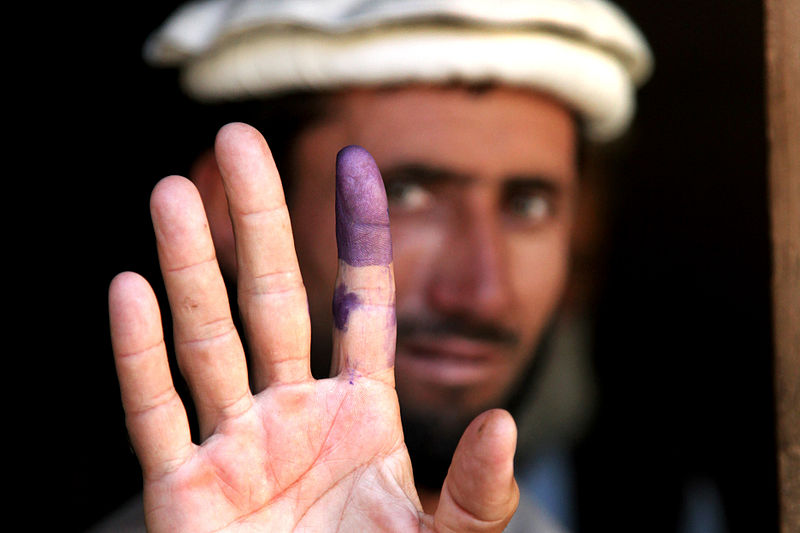The Islamic State’s rise to notoriety comes at a time when foreign intervention is a heavily criticized course of action, when sectarian violence has reached near-climax proportions, and when regional turmoil provides just the right ingredients for expansionist agendas.
The roots of the group can be traced back to just after the invasion of Iraq by U.S. forces in 2003. A group by the name of Tawhid, run by Abu Musab al-Zarqawi, a Sunni of Jordanian descent, was known for launching several attacks against U.S. and Iraqi forces. In a move to boost his strength and resources, Zarqawi declared his allegiance to al-Qaeda in 2004, prompting the group to rebrand itself as al-Qaeda in Iraq (AQI). Zarqawi, seen here in rare footage, was eventually killed in 2006.
Abu Omar al-Baghdadi took over AQI and rebranded the group into the Islamic State in Iraq (ISI). U.S. forces, however, also killed Baghdadi in 2010, resulting in new leadership under Abu Bakr al-Baghdadi and a call for a transnational caliphate with Baghdadi as its caliph.
It was under the second Baghdadi that the group took over the international spotlight through its blitzkrieg seizures of swaths of Iraqi and Syrian real estate. Baghdadi was quick to exploit the inter-communal fighting in Iraq and the sectarian civil war in Syria to lure fighters to his cause. The result was a domino effect as various groups began pledging their allegiance to Baghdadi, significantly swelling his ranks. After a brief merger between the Islamic State and the Nusra Front (al-Qaeda’s main faction in Syria), Al-Qaeda renounced this move citing preferences for Baghdadi and his group to remain in Iraq. Baghdadi rejected this denunciation and criticized al-Qaeda for ‘deviating’ from the correct path of Jihad, leading to an eventual break between the two groups.
There are several factors that not only allowed the Islamic State to grow in size and strength, but also to pose a large enough regional threat to warrant global attention. There were three key events that, while happening at different times over the last decade, at some point overlapped one another. This intersecting culminated in the perfect components to facilitate the rise of the Islamic State.
2003 Invasion
 The regime of Saddam Hussein was as brutal and repressive as they come. He violently suppressed the Shiites in Iraq, who had constituted a majority of the population, and still do to this day. His rivals were savagely murdered and his allies equally feared him. For years, a minority clan had ruled over the majority in Iraq just as it does in Syria. In March 2003, then U.S. President George W. Bush led an invasion of Iraq alongside his ‘coalition of the willing’. The task was simple, remove Saddam Hussein from power and eliminate the threat of his weapons of mass destruction (WMD). Of course what resulted was years of war, a staggering bill, and the loss of many American and Iraqi lives. The U.S. military was ultimately unsuccessful in locating any WMDs and while the reasons behind the invasion are still debated, the implications of the offensive, and the power vacuum it created, have lasting effects to this date.
The regime of Saddam Hussein was as brutal and repressive as they come. He violently suppressed the Shiites in Iraq, who had constituted a majority of the population, and still do to this day. His rivals were savagely murdered and his allies equally feared him. For years, a minority clan had ruled over the majority in Iraq just as it does in Syria. In March 2003, then U.S. President George W. Bush led an invasion of Iraq alongside his ‘coalition of the willing’. The task was simple, remove Saddam Hussein from power and eliminate the threat of his weapons of mass destruction (WMD). Of course what resulted was years of war, a staggering bill, and the loss of many American and Iraqi lives. The U.S. military was ultimately unsuccessful in locating any WMDs and while the reasons behind the invasion are still debated, the implications of the offensive, and the power vacuum it created, have lasting effects to this date.
After the United States toppled Saddam and his Ba’athist regime, the Bush administration had thought, naively, that the people of Iraq would welcome this change and begin the process towards a western style liberal democracy. What the United States failed to realize was that the people who constitute the majority saw this as a prime opportunity for the re-distribution of power long held in the hands of those they considered to be their oppressors. This re-distribution ultimately resulted in a consolidation of power.
Without an adequate post-invasion plan, Iraq quickly disintegrated into chaos and became a breeding ground for extremism and fanaticism. In a bid to secure power, a civil war broke out as sectarian violence threatened to rip the country apart. Al Qaeda ranks began to swell once again as attacks on religious holy sites increased, further deepening the divide between communities.
Maliki
In April 2003, Nouri al-Maliki, a Shiite and former political exile, returned to Iraq to become the deputy leader of the ‘Supreme National de-Baathification Commission’. A report released by the International Centre for Transitional Justice outlined the process in which Iraq was purged of this Baathist influence. The indiscriminate procedure resulted in the dismissal of thousands of individuals based on party affiliation rather than their daily conduct. It is important to note that under Saddam, it was mandatory to be aligned with the Baathist party in order to work for the government. Therefore it was unsurprising that such policies contributed to civil unrest. In 2005, Maliki was then elected to the transitional National Assembly and was eventually involved in the drafting of Iraq’s new constitution.
By 2006, Ibrahim al-Jaafari, Iraq’s first post war prime minister, faced mounting criticism over his ineffective leadership, and was eventually forced to step aside. This led to the subsequent takeover of the prime minister’s post by none other than Maliki. During his tenure as prime minister, Iraq quickly began to resemble an authoritarian state more commonly associated with the Saddam Hussein era rather than the western-style democracy the United States had hoped for. Maliki instigated policies that critics argue fueled the sectarianism in Iraq by alienating Sunnis and Kurds alike.
 Maliki used de-Baathification laws to target and eliminate his rivals in an attempt to consolidate his control. He did this by arresting several outspoken Sunni tribal leaders after his government failed to meet a quota to include Sunni Iraqis into the security forces. Maliki was also responsible for the quashing of anti-government protests in Ramadi, a Sunni dominated area. In 2011, Maliki went as far as issuing a warrant for the arrest of then Sunni vice-president Tariq al-Hashimi only a few days after U.S. forces had left Iraq. Hashimi, now a political exile, was later quoted as saying “Maliki has given the green light to Shia militias that are linked to Iran to kidnap, kill and displace as they please in Iraq”.
Maliki used de-Baathification laws to target and eliminate his rivals in an attempt to consolidate his control. He did this by arresting several outspoken Sunni tribal leaders after his government failed to meet a quota to include Sunni Iraqis into the security forces. Maliki was also responsible for the quashing of anti-government protests in Ramadi, a Sunni dominated area. In 2011, Maliki went as far as issuing a warrant for the arrest of then Sunni vice-president Tariq al-Hashimi only a few days after U.S. forces had left Iraq. Hashimi, now a political exile, was later quoted as saying “Maliki has given the green light to Shia militias that are linked to Iran to kidnap, kill and displace as they please in Iraq”.
Syria
The third and final factor that facilitated the rise of the Islamic State was the turmoil that was about to reach breaking point in Syria. In 2011, riding the wave of the Arab Spring, anti-government protests erupted. Government forces under president Bashar al-Assad, violently suppressed the protests. Eventually protestors became rebels and a civil war ensued. Militants from all over the region began to flock into Syria taking up arms and not only battling Assad’s forces but also other rebel factions a well.
Syria had officially descended into a Hobbesian like ‘state of nature’. Baghdadi used the chaos to capitalize on a secular revolution that was largely stagnating. Recruiting other rebel factions into his ranks and securing key resources, Baghdadi was able to exploit the situation in Syria to facilitate the group’s growth across borders. Battle hardened from Iraq, Baghdadi’s fighters were a much more potent force crushing other rebel factions with ease. Government forces did not fare much better. The capturing of various oil fields in eastern Syria allowed the group to fill its coffers providing them with the means to recruit more fighters.
 There is a rising stream of thought that has Assad being purposefully responsible for the rise of IS in Syria. Such a perverse strategy would serve to back the West into a corner where it must choose between Assad and the Islamic State. According to an article in the National Post, it is suggested that Assad has purchased oil originating from Islamic State captured fields. The article also claims that in 2012, when IS was still confined to small parts of Iraq, Assad began to quietly empty out the Sednaya jail near Damascus. Among those released were some of the most dangerous anti-government jihadists. Lastly the article points to government bombings of areas where the more moderate, and U.S. backed, Free Syrian Army was located. Meanwhile Raqqa, the unofficial capital of the Islamic State, was left relatively untouched.
There is a rising stream of thought that has Assad being purposefully responsible for the rise of IS in Syria. Such a perverse strategy would serve to back the West into a corner where it must choose between Assad and the Islamic State. According to an article in the National Post, it is suggested that Assad has purchased oil originating from Islamic State captured fields. The article also claims that in 2012, when IS was still confined to small parts of Iraq, Assad began to quietly empty out the Sednaya jail near Damascus. Among those released were some of the most dangerous anti-government jihadists. Lastly the article points to government bombings of areas where the more moderate, and U.S. backed, Free Syrian Army was located. Meanwhile Raqqa, the unofficial capital of the Islamic State, was left relatively untouched.
The 2003 invasion of Iraq served as a catalyst for the rise of extremism. Had the United States been more adequately prepared for post-war Iraq, different segments of the population might not have been so easily persuaded to take up arms. Had the Maliki government been more inclusive for the years he was in power, Sunni tribal leaders would have denounced extremist agendas rather than encourage them. Finally, had the Syrian civil war remained secular in nature, had western and regional governments not backed various rebel factions, perhaps the Islamic State would have continued to be confined to small parts of Iraq.




